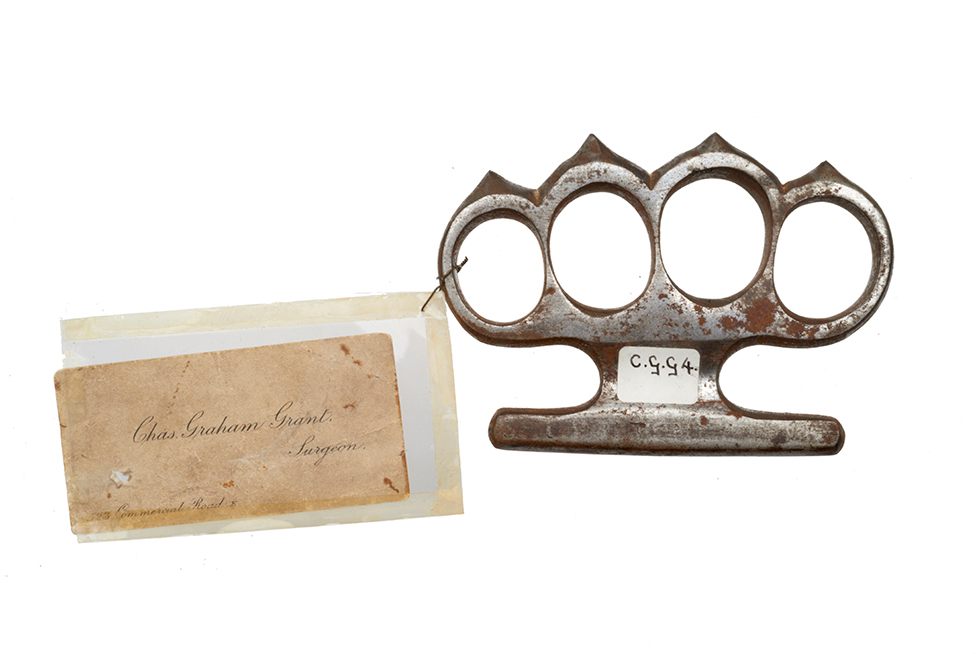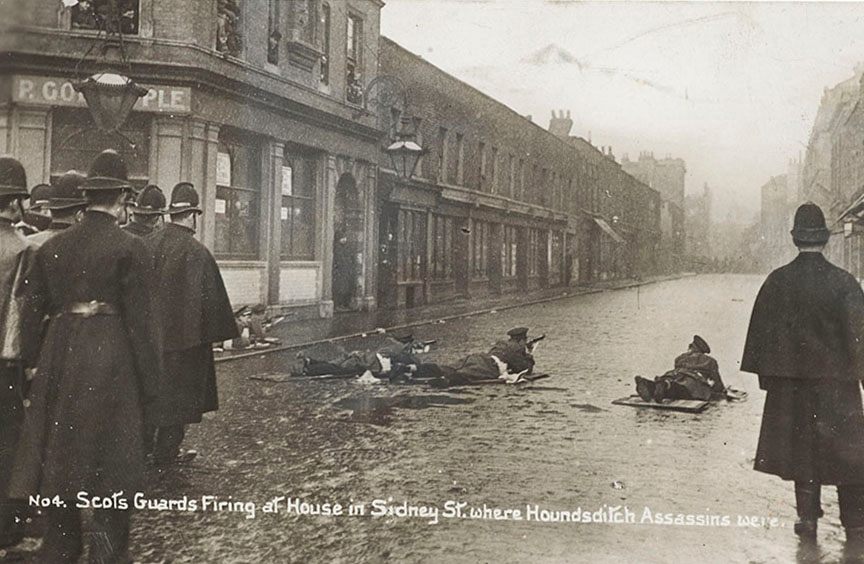Getting in the Minds of Murderers at London’s Hidden Crime Museum
Inside the Metropolitan Police’s hidden Crime Museum at Scotland Yard, c. 1900. (All Photos: © Museum of London)
Many of the items on display look innocuous enough; a silk scarf, a pair of stockings, an old garden spade, a rusted kitchen knife. But each artifact in the Metropolitan Police’s legendary Crime Museum has a grisly story to tell.
The collection of crime evidence from London’s most notorious cases was established in the 1870s, and has never been open to the public. For a short time—until April 10, 2016—the Museum of London, in conjunction with the Metropolitan Police, is displaying part of the collection, previously only seen by the police and specially invited guests.
From the beginning, people spoke in whispers about what might be contained in this secret repository, known as the Black Museum. Such was the mystery, that in his weekly 1940s radio show, Orson Welles began with an ominous announcement: “This is Orson Welles, speaking from London. The Black Museum, a repository of death … a warehouse of homicide.” His stentorian voice was punctuated with dramatic music and the sound of Big Ben bonging.

Knuckleduster used in an assault, c. late 19th or early 20th century.
In reality, the Crime Museum originated with something much more mundane; a simple change in the law. Under the new Prisoners Property Act of 1869, police were required to keep a prisoner’s property until they were released. Often, however, these personal possessions were left unclaimed, particularly when the prisoner was executed.
Soon the Central Prisoner’s Property Store of the Metropolitan Police headquarters, Great Scotland Yard, was filled with discarded property. An Inspector Neame is credited with the idea of turning this collection of the unclaimed into a museum that could be used to train police cadets. It is still used for that purpose.

Postcard from The Siege of Sidney Street, the first armed siege to be recorded on film, 1911.
A lot of these items were weapons that trainee police officers might expect to see on the streets of London. But these objects came with backstories. New police recruits would peer in a display case at a rusty, barbaric-looking knuckleduster with the accession tag reading, “Assault. Three blows ten wounds. Bridge of nose broken and destroyed permanently. Sentence 3 months.”
To these confiscated weapons, knives, cudgels, brick pats and pistols, Neame added artifacts that had been used as evidence in police cases, such as items from which lifted fingerprints had first been used to successfully prosecute, and casts of shoe prints made at crime scenes. The Crime Museum became a library of important cases, showcasing the history of detective work, and the development and modernization of Scotland Yard’s techniques.

Jack the Ripper appeal for information poster issued by Metropolitan Police, 1888.
The first half of the Museum of London’s exhibit is inspired by illustrations of the original museum set up by Neame. It has the air of a parlor room, with sash windows, shelving, displays cases and a fireplace, resembling a Victorian cabinet of curiosities. Court room sketches by William Hartley lie alongside weapons such as the pistol that 18-year-old Edward Oxford fired at Queen Victoria on June 10, 1840. (He was found guilty of treason, but sentenced to confinement in a mental hospital for reasons of insanity.)
Stephen Greenhalgh, Deputy Mayor for Policing and Crime, explains that victims’ stories, which are all too often forgotten, are at the heart of this exhibition: “They are a compelling reminder of the impact crime can have on people’s lives and how important police work is in detecting and bringing criminals to justice.”
High along the wall are rows of original death masks, created after executions at Newgate Prison. They were made for phrenological purposes; pioneering the study of the shape of criminal heads, such as that of Franz Muller, 34, who committed the first recorded murder on a train. Some objects are curious, such as a pin cushion from 1879, embroidered by the imprisoned Annie Parker with her own hair. Parker was arrested over 400 times on charges of drunkenness.

Pin-cushion embroidered with human hair by Annie Parker, 1879.
Other items are much more chilling: a long case running along one wall is lined with coarse, thick ropes. Each was used to hang someone. One rope was wrapped around the neck of Amelia Dyer, aged 57, on June 10, 1896. Dyer was one of Victorian England’s most notorious “baby farmers”—women paid to look after unwanted children anonymously. Next to the rope is a letter Dyer wrote to the mother of one of the children in her care, two-month-old Doris Marmon: “baby is ill with bronchitis, but is better today.” The truth was far worse. Seven babies were recovered, drowned in the Thames, their murders attributed to Amelia Dyer, including that of Doris.
The process of exhibiting such disturbing artifacts required a delicate approach. Jackie Keily, curator of the “Crime Museum Uncovered” exhibition at the Museum of London, explains that they “were given free rein by the Metropolitan Police Service to decide what cases and objects to use and what stories to tell.”
Working closely with the Mayor’s Office for Policing and Crime, the Museum of London wanted to “draw out the human stories, the people stories” as well as highlighting “cases that helped to change the law, or helped to develop new methods of investigation or forensics.”

The Krays briefcase with syringe and poison.
Much of the historical fascination with the Crime Museum is that it was closed to the public. To gain access to the collection you had to be a member of the Metropolitan Police, from a visiting police force, or among those who, as Keily explained, had “a direct link to an investigation or special guests, such as VIPs—Arthur Conan Doyle, for example—and members of the Royal Family.” These policies are still in place.
One visitor to the original museum wasn’t a household name, but he may have been the most feared man in Britain. His business card is on display, giving his name as WM Marwood. His job title is printed in capitals: EXECUTIONER. Marwood was the chief hangman for the British government and devised the “long drop,” which was considered a more humane way of dispatching those in his ward. He hanged over 170 people, including the famed Victorian cat burglar Charles Peace (whose collection of lock picks, skeleton keys and hinged folding ladders are also on display).
Along with Marwood’s business card is a letter from the Crime Museum, asking for artifacts for the collection, particularly his personal hanging rope. Hereplied, “I feel very much surprised at your letter. My rope I never let go out of my hands to anyone.” However, Marwood did pay a visit to the Crime Museum on June 18, 1883. In the address column of the Visitor’s book, he wrote, simply, “hangman.”

Scotland Yard Crime Museum, 2015.
The second half of the museum deals with 24 criminal cases dating from 1905 onwards. “The stories are often uncomfortable, even disturbing but they provide an important insight into the diverse aspects of London’s history,” Keily and co-curator Julia Hoffbrand write, of these gory crime relics from the not-so-distant past.
The objects on display are often brutal in their simplicity; take, for example, a 1920s luggage trunk that was dropped off at the left luggage office of Charing Cross railway station. It was left unclaimed, until a vile smell started coming from it. Opening the trunk, the railway staff were horrified to discover the remains of a woman.

Spade used by Dr Crippen to bury his wife, Cora, in 1910.
One cabinet shows a common old garden spade suspended above some dirty rags. This was the spade allegedly used by Dr. Hawley Harvey Crippen to bury the mutilated remains of his wife Cora in the basement of their home. The fragments of cloth were the pajamas he used to wrap her body in. Crippen and his mistress fled for Canada, but were hunted down while still crossing the Atlantic, in one of the first cases of a wireless telegram being used to apprehend a criminal. (They were met by police before disembarking)

Acid Bath Murderer, 1949.
As the exhibit continues, the objects add to a growing sense of gruesomeness. There’s a collection of knives, tin openers, pokers and hair tongs used by Gordon “Blackout Ripper” Cummins to murder and mutilate his four victims during London’s Blitz in World War II. Then there are the rubber apron, gloves and gas mask of John Haigh. The notorious “Acid Bath Killer” murdered six people during the 1940s and dissolved their bodies in a drum of sulphuric acid.

Medicine case belonging to poisoner and Jack the Ripper suspect Dr Neil Cream, c. 1892.
In her book The Invention of Murder: How the Victorians Reveled in Death and Detection and Created Modern Crime, Judith Flanders writes that “crime, especially murder, is very pleasant to think about in the abstract: it is like hearing blustery rain on the windowpane when sitting indoors.”
Visitors to the Crime Museum and its collection of murder weapons, death masks and crime scene evidence today seem as drawn to the morbid as their counterparts in the Victorian era were.
But unlike the original museum with a parlor room feel, the contemporary exhibit makes room for the lesser known victims who have been forgotten from the history books. As Keily writes, “all too often we remember crimes by the names of the offenders … But the victims, of course, are the people we should remember.”








Follow us on Twitter to get the latest on the world's hidden wonders.
Like us on Facebook to get the latest on the world's hidden wonders.
Follow us on Twitter Like us on Facebook